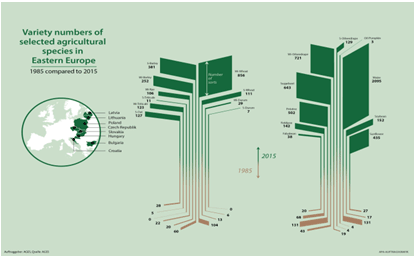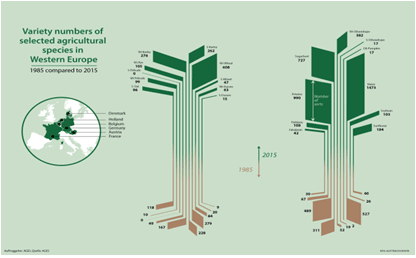Austria
October 18, 2016
Biodiversity of agricultural crops was a topic of an EU-meeting in Croatia in September this year. Thirteen EU-MemberStates (MS: BG, CZ, HR, HU, LT, LV, PL, and SK; AT, BE, DE, DK, FR, NL) delivered their variety numbers of the most important field crops and other relevant statistical data from 1985 and 2015. This enables the coordinator AGES (Austrian Agency for Health and Food Safety) to elaborate graphs which give a representative overview over the number and he evolution of variety numbers of traditional and new crop species as a whole, but also for different Europian regions. It get obvious that also the year of joining the EU influences the evolution of the national variety lists.
In the eighties of the last century there have been listed eight cereal crops in the eastern part of Europe versus nine cereal crops in the western part of Europe with in sum 264 varieties in the East versus 964 in the West (Graph 1 and 2).


Thirty years later in 2015 more than two thousand varieties (2002) of the mentioned species show up on the National Lists of the East (multiplication factor 7,6) whereas 1571 varieties have been enumerated in the West (multiplication factor only 1,6)! Spring-Durum and Spring-Triticale have not been seeded at all in the east continental part of Europe in the past whereas they are grown nowadays with some varieties. In the western part in former years spring-durums have been cultivated all the time but up until now no spring-triticales are listed or cultivated. In all ten species the number of varieties increased which is very eye-catching in winter-wheat. In this species registered variety numbers doubled in the West whereas multiplicated a little bit more than eightfold in the East.
The ten noncereal crops have been in production in both regions all over these 30 years. In the concerned time period variety numbers multiplicated for the West more than 2,5 fold (1563 to 4043 varieties) and for the East more than 10,5 fold (464 to 4860 varieties)! Especially this species group shows in a unique way how agriculture changed f.e. in Maize and Winter-Oilseedrape. In the East the number of corn varieties enlarged sixteen-fold (131 to 2095 varieties) and in rape thirtyeight-fold (19 to 721 varieties). Contrary to the East corn in the West only tripled (527 to 1473 varieties) and rape respectively increased sevenfold (52 to 382 varieties). The increase in other oilseeds like sunflower and soybean as well as in sugarbeet show a similar development in the East in comparison to the West during this time which is also reflected by the incremental production areas of these crops.
A showcase example in oilseedrape looking after the genetic background of the 2015 listed 192 varieties in Austria and the neighbour countries -the Czech Republic, Slovakia and Hungaria- resulted in the finding that each rapeseed-hybrid consists on average of 1,7 different components (varieties, breedinglines etc.) in different combinations. These 192 winter rape varieties belong to 28 different breeders. Only three varieties of this species are registered in all these four and 20 varieties in three of these four neighbouring countries. Similar results have been generated with variety intersection matrices of barley, corn, soybean, sunflower and winterwheat together with some more EU-MS. But these species have not been elaborated in such detail as in rapeseed.
A special look to Austria having started this biodiversity approach shows, that soybean, sunflower, pumpkin, winter oilseedrape, winter triticale, spring and winter durum cultivars have not been cultivated at all in the late sixties of the last century (http://www.saatgut-austria.at/page.asp/-/Sortenvielfalt). These “new species” have been seeded 2015 on ca. 200 000 hectars, an equivalent of 15 % of the national arable land (1,35 mio ha)! Thus farmer have nowadays a larger choice which species they put in their crop rotation and additionally these species also contribute to minimize fertilizer and pesticides use and facilitates a more environment friendly field management. Another fact is that farmers are in the position to select out of a significant larger variety supply of different breeders than 50 years ago.
As of late the Austrian farmers now are supported by a new interactive webtool to select the best varieties for their region, their special local conditions or crop rotations for agro species as wheat, corn etc. (https://www.ages.at/themen/landwirtschaft/sorte/sortenfinder-online/) with a very high number of varieties.